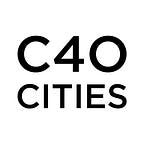COVID-19 has transformed how we live and work. Now is the moment to make low-carbon lifestyles the norm.
By Mark Watts, Executive Director of C40 Cities, and Julia Lipton, Director of Climate Action Planning and Innovation at C40 Cities
Last month’s Intergovernmental Panel on Climate Change report — labelled ‘code red for humanity’ — has been one headline in a summer of bad news about the climate, as a seemingly relentless wave of wildfires, floods, extreme heat and droughts continues to cause devastation across the globe. We have an extremely short time in which to act. But if the past 18 months have shown us anything, it’s how much, and how quickly, mindsets can shift in a crisis. The social and economic impact of COVID-19 has driven revolutions in remote working and local experiences; city leaders can use this moment to ensure the recovery from COVID is green, as well as fast and fair, and make low-carbon lifestyles not only possible, but desirable.
This summer’s extreme weather across the Northern Hemisphere offers a frightening snapshot of the future, should we return to polluting business as usual. It’s clear that people want change. A survey of public opinion in G20 countries carried out earlier this year — even before the tragic events of this summer — found that 73% of people agreed that the economy should move beyond a focus on profit and economic growth, and focus more on human wellbeing and protection for nature. It is an approach that enlightened city leaders have already adopted and mayors can, and are, seizing this moment to enable a human-centred, equitable and green recovery from the pandemic.
Cities are already at the forefront of climate action: at the time of writing, at least 64 global cities are already cutting emissions year on year, delivering their fair share of halving global emissions this decade, and constraining temperature rise to the 1.5°C maximum that science shows is essential. As a result of their leadership, 800 cities across the world have committed to the same goals as part of Cities Race to Zero. With powers over transport and buildings, action by cities has long been key to the climate fight.
Recently, though, we’ve seen that the pandemic has accelerated a shift towards the idea of the city as a system that can enable people to live a more sustainable life. The disruption of the last 18 months has opened up the space for a radical rethink of urban living. The future of work and the central business district remains unclear, but it seems certain we can expect to see more hybrid patterns of working, creating an opening for multiple, thriving, mixed use neighbourhoods. In recent months we’ve seen city after city developing a local version of the ’15 minute city,’ in which urban life is organised so that people can meet their everyday needs within a short walk or bike ride. With more green space, local cultural life, and less space given to cars, cities can facilitate low-carbon lifestyles by making it attractive to work and play locally.
Sustainable lifestyles are facilitated by the norms and infrastructure that shape individual choices — something that cities have enormous power to influence on a daily basis. Los Angeles has a plan to have all low-income residents living within half mile from a store selling fresh food, while Milan has reduced the emissions from its school meals by 20% over the past 5 years by shifting menus towards more plant-based and sustainable ingredients. These cities are making it easier for people to lead healthier, low-carbon lifestyles.
In Barcelona, the city is rolling out ‘Superblocks’ designed to encourage social cohesion and collaboration by minimising traffic and opening up urban space to multiple uses — walking, cycling, hanging out. Under its 10 year plan, one in 3 streets in the central Eixample district will become green zones which give priority to pedestrians and cyclists. In other words, Barcelona is designing neighbourhoods for humans while reducing emissions in the process.
Our behaviours change — at key moments in our lives, when we have children, retire or move home. They can change at speed and be normalised in times of crisis. The shift to lifestyles that reduce the pressure on our environment will mean communities organising themselves so they can thrive without waste and without increasing material consumption. Cities have the power to put policies in place that foster that. Glasgow has a vision for an alternative economy based on fixing and sharing as a gateway to stimulate civic participation — among the city’s initiatives are plans to expand community food growing and stimulate the ‘share and repair’ economy by fostering small businesses that promote the reuse of items like clothing and electronics. This is how a city helps to make low-consumption lifestyles possible for all people.
Cities have huge power to maximise benefit to citizens while minimising impact to the planet, but it requires a proactive, thoughtful and collaborative approach. Portland is prioritising low-income communities and communities of colour for grants for clean energy, green jobs, and regenerative agriculture. It’s also using participatory methods through the Climate Justice initiative, a space for Black, Indigenous and communities of colour to co-create intersectional climate justice solutions that centre the perspectives of frontline communities.
How we live, work and play in cities will never be the same, but cities can act now to influence how the revolution plays out. In re-shaping the city we re-shape society.
